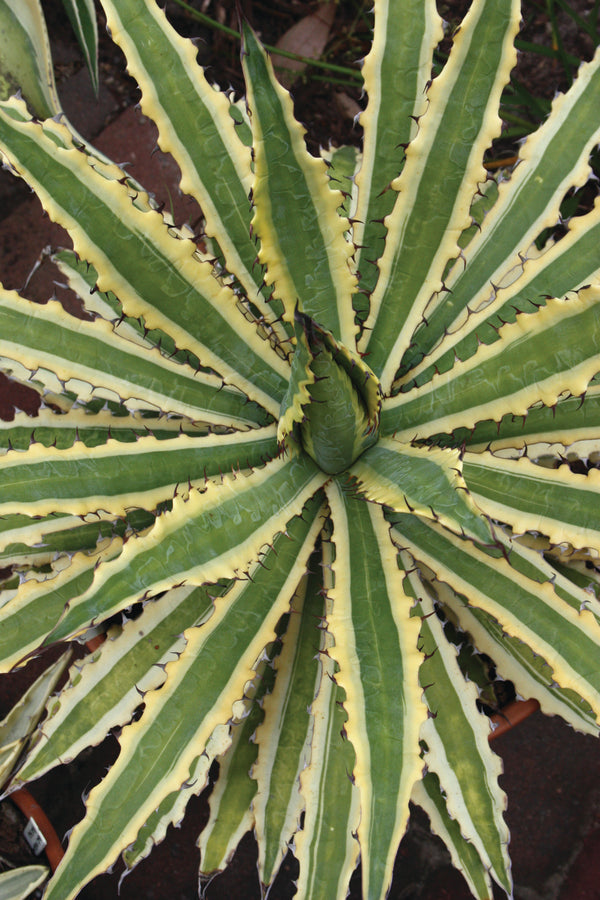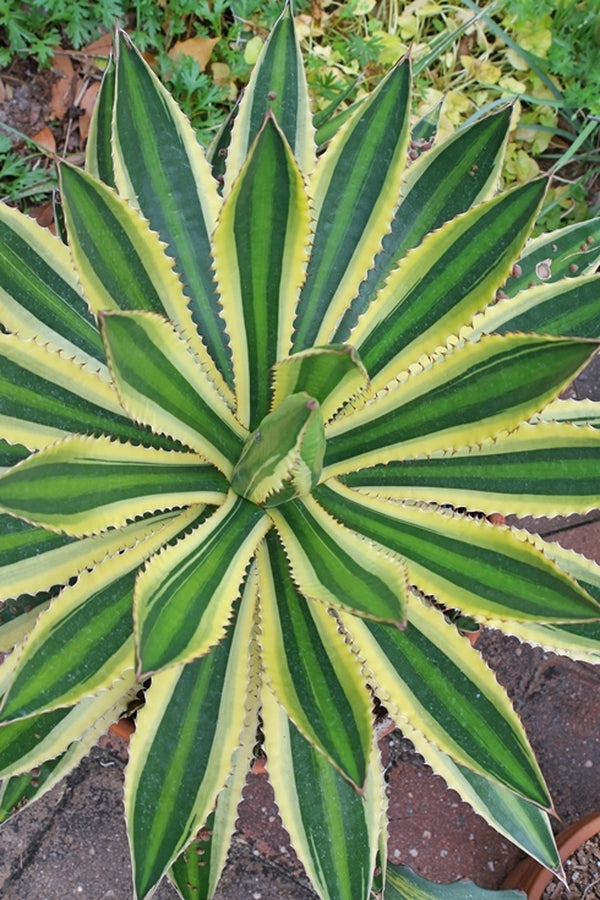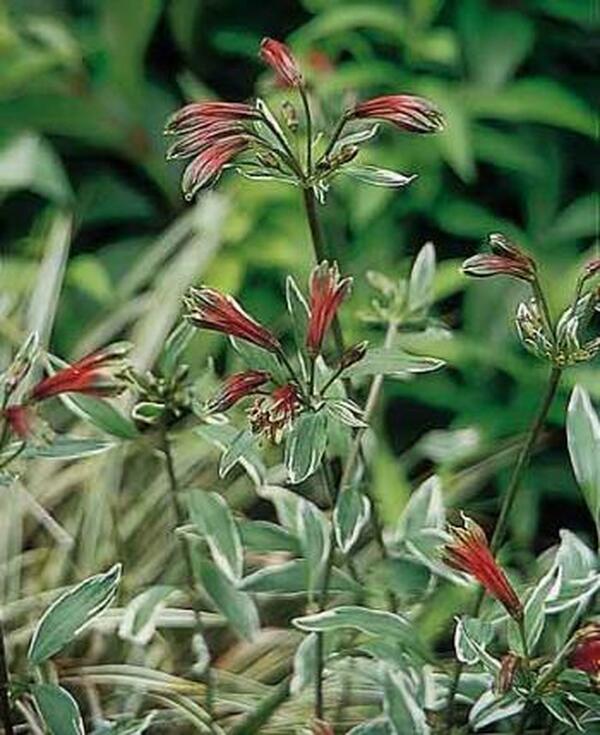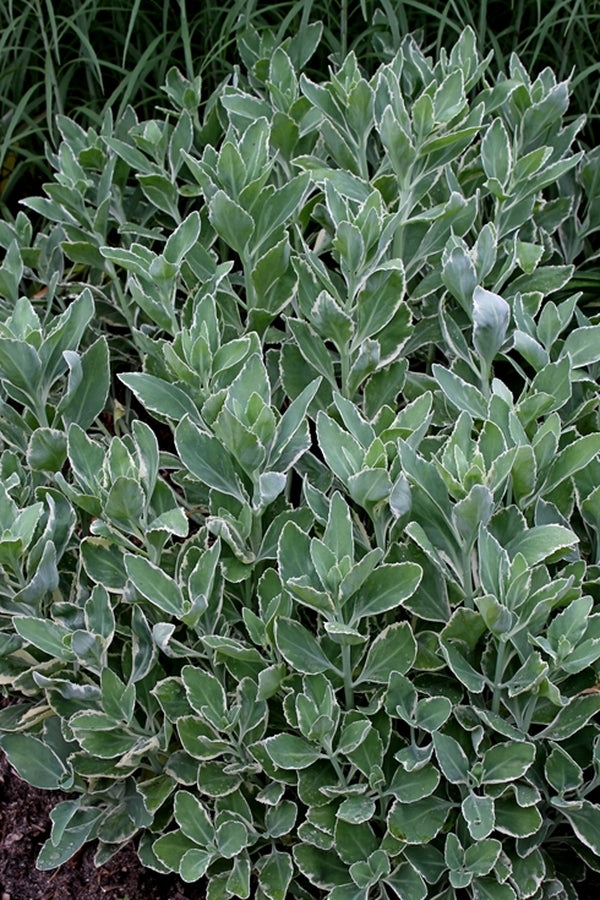Yuck...as one visitor described a variegated plant. When I asked why, he likened using variegated plants to trying to match plaids with stripes...hmmm. Variegated plants suffer from the outdated belief that all plants are supposed to be green. Plants which aren't green, are somehow seen as sick or unworthy of cultivation.
Agave xylonacantha 'Frostbite'
Variegated plants are most appreciated by serious plant collectors, probably because of their uniqueness. If everyone has a green form of plant X, then the plant collector naturally wants to have the variegated form, often simply to be different. One mail order nursery, Glasshouse Works in Stewart Ohio, has as one of their goals to be the best source of variegated plants in the country.
Many variegated plants are so unusual that they will forever be relegated to the status of collector plants. Being a plant collector, I value these plants some for their beauty, but most for their being unusual. The challenge of blending large numbers of these plants into the garden is one worthy of even the finest designer.
Some gardeners like the patterning in the leaf...usually the arts and croissant crowd. Designers often like the ability of variegated plants to lighten up a normally dark landscape. In a landscape design, variegated plants are often used as the center of attention or as a focal point in the landscape. Despite the prejudice against variegated plants as a group, there are many that have still become mainstream landscape plants.
Agave lophantha 'Quadricolor'
Inquiring minds want to know what qualifies as a variegation. Variegation in plants is defined as the normal green portion of the plant leaf being replaced by white, cream, yellow, or occasionally other colors, which may be in the form of blotches or stripes. The variegations can occur on the edge of the leaves (marginate variegation), or in the center of the leaf (medio variegation.) Variegated plants which have neat regular leaf margins of white or gold and tend to be the most accepted by gardeners.
Less accepted by gardeners are variegated plants whose foliage is streaked with uneven patterning. These plants are often highly prized by plant collectors and completely shunned by most other gardeners. I must admit that most of these plants have foliage that sometimes resembles a classic case of micronutrient deficiency. The most common example is that of the variegated canna lily (Canna Nirvana ...syn Minerva). The strangest of variegations of course are the horizontal banding, seen in some of the ornamental grasses.
As a general rule, the variegated forms of most plants are far less vigorous than their green counterpart. This can easily be accounted for by the lack of chlorophyll in the variegated sections of the leaf. Many variegates lack enough chlorophyll to live once they are severed from the mother plant. Research has found that many variegated plants also tend to suffer more insect damage on the variegated parts of the foliage than in the green areas, obviously due to the weaker tissue. This is certainly not true on all variegated plants, but varies tremendously from plant to plant.
If the variegated sports are strong enough to support themselves, the questions of stability enters the picture. Many variegations will not maintain their identity, as they often have a tendency to revert back to their original more vigorous parents. If a solid green branch or shoot appears, then it should be removed immediately to retain the integrity of the variegated plant. Often seedlings will have streaked variegation when young, but will eventually settle down with age, either to an edge, center, or back to solid green.
Ajuga reptans 'Binparcol' PP 20,293
While we may be fond of variegated plants on their own merits, they require much more effort to blend into the landscape. Plants with bold variegation seemingly scream for attention in the garden, hence their use as accent plants. As with all brightly variegated plants, they show off best when contrasted against a dark background. Whether planted against a mostly green hedge, or a larger backdrop of deciduous trees, some background is needed to properly display variegated trees and shrubs.
One of my favorites is the giant variegated dogwood, Cornus controversa Variegata. This spectacular tree is unfortunately seldom seen in this country. The wonderful specimens at White Flower Farm in Litchfield Connecticut are well worth the drive to view. The variegation is a good wide clean white edge contrasted against the dark green leaf center, and the nearly black stems.
There are other wonderful variegated dogwoods, both in the small tree and bush forms. Cornus florida has yielded many selections such as Cherokee Daybreak (white variegation and white flowers), Cherokee Sunset (yellow variegation and pink flowers), First Lady (yellow variegation and white flowers), just to mention a few.
Not to be overlooked is another species, Cornus kousa. Two great selections exist, Cornus kousa Snowboy with spectacular white edged foliage, which looks as though each leaf was hand painted. My personal favorite is Cornus kousa Gold Star, which has been on my lust list since seeing a spectacular specimen at John Elsley's garden in South Carolina, and at Jim Crosses nursery Environmentals on Long Island. Gold Star has a wide creamy yellow band through the center of each leaf. Although some specimens seem to revert, others appear completely stable.
Alstroemeria psittacina 'Variegata'
Less heat tolerant (through zone 7), but no less wonderful are the variegated bush dogwoods. These bush dogwoods are another great example of variegation in the genus, with Cornus alba Elegantissima (green with white edge, red stems) being the most popular. Cornus sericea Silver and Gold gives the same leaf pattern, but with yellow stems. Cornus alba Gouchaultii is a lesser known cultivar which has yellow leaf margins combined with the red stems. As you can easily see, there is no shortage of variegation in the Cornus family.
Shrubs comprise the majority of mainstream variegated plants due to their potential use, or in many cases misuse around homes. The backbone of most gardens is the euonymus, of which variegated forms abound. My favorite of the upright forms remains Euonymus japonica Silver King. This upright growing form has beautiful dark green leaves with wide creamy white edges. The upright euonymus make great vertical accents in the garden. As with all euonymus, scale insects are a great concern. I have found that by limiting the number of euonymus in my garden, I have never had a problem with this insect.
Of the ground cover euonymus, Euonymus Emerald 'n Gold (green and yellow variegation), and Emerald Gaiety (white and gold variegation) are two favorites. These semi upright spreaders make large mats of evergreen color. Their versatility of growing both in sun and shade has made these plants a staple of every discount grocery store in the country. Another lesser known, but equally wonderful cultivar is Euonymus fortunei Harlequin. This new cultivar has mottled dark green and white leaves, and is quite striking...watch for it in your area soon.
In most of the country (zones 4-8), even the conifers have joined the picture, although variegation in this family is far from common. The most popular variegated conifer is the dragon's eye pine. Pinus densiflora Oculus draconis makes a spectacular sight with its horizontal banding of yellow and green. There are several fairly similar cultivars of Pinus densiflora and Pinus thunbergiana with reversal of color patterns which are extremely difficult to find in the trade.
Aristolochia fimbriata
The false cypress have as their representative Chamaecyparis pisifera Snow. This dwarf has light green foliage, tipped with a dusting of white 'Snow'. The light color on the tips burns easily in the south and must be grown in partial shade. Cryptomeria japonica Albo Spicata has a very similar habit with a nice dusting of white over the branches of this slow growing cultivar.
Not to be outdone are the backbone of the garden conifers the arborvitae. Thuja occidentalis Sherwood Frost is a beautiful slow growing cultivar with a dusting of white that becomes more prevalent in late summer and fall. One of my favorites Thuja plicata Zebrina has stunning variegation of gold and green, but unfortunately does not color well in our heat. Perhaps in the pacific northwest and in more northerly climates, this cultivar would be highly prized.
In the deciduous shrub category, the choices are more limited than in most groups. Forsythias are a group of plants from which several variegated cultivars have been selected. Unfortunately all of them have been dogs (at least in the south), until now. From Duncan and Davies Nursery in New Zealand comes Forsythia Fiesta. I fell in love with this several years ago, when I acquired the plant from Roy Klehm of Illinois. This dwarf forsythia (3' x 3") has beautiful gold foliage with a stable green edge. This is a plant which is still quite unknown in American gardens.
Hydrangea macrophylla 'Maculata'
Down here in the south, we can grow many of the more tender shrubs such as variegated aucubas, variegated hydrangeas, variegated viburnum tinus, and variegated gardenias. Even here in the warmer section of zone 7b, however, a severe winter will take a toll on some of these choice plants. Many variegates have proven less hardy than their green counterparts.
Perennials offer a wide range of variegated choices, from the ground covers, to variegated choices of mainstream perennials.
Ornamental grasses are a personal favorite for that sunny spot in the garden. From zone 5 southward, folks are gradually learning about the variegated miscanthus. The most common of course is Miscanthus sinensis Variegatus, a relatively large clumping grass with dynamic vertical striping, giving an almost white appearance from quite a distance. The biggest breakthrough for smaller gardens was the introduction of Miscanthus Morning Light. This very narrow leaf variegated cultivar is at home in even the smallest city gardens. The variegation on Miscanthus Morning Light is so subtle, and the texture so delicate, that even those who hate variegated plants would fall in love with this grass.
Miscanthus sinensis 'Gold Bar' PP 15,193
As I mentioned earlier, the miscanthus also contain some horizontal banded grasses. Miscanthus sinensis Zebrinus is a large imposing clump, while Miscanthus sinensis Strictus is a heavier striped, but very upright selection. A new selection from North Carolina is Miscanthus sinensis Kirk Alexander. While not as heavily striped, the dwarf stature and wonderful plumage makes this a certain hit with the owners of small gardens.
Other variegated grasses of note include the fabulous Calamagrostis ‘Overdam’. This new striking medium size clumper is one of the finest, yet virtually unknown variegated grass available. When used against a background of blue or green, the leaf variegation is accented even more. Another grass that has never caught on is the dwarf striped tuber oat grass (Arrhenatherum elatius bulbosum Variegatum). Perhaps the ridiculously long name, keeps gardeners from growing this striking white edged grass, that looks great through the winter, and only goes dormant during the summer when other plants easily fill the void.
Carex is a similar group of plants that share the grasses affinity for variegation, but prefer to grow in part sun to light shade. The most widely sold sedge is Carex hachijoensis Evergold (or Old Gold). This striped weeping sedge is the perfect foil for a water feature with it's graceful foliage. Carex morrowi temnolepis is similar in stature, but with much finer texture, and an overall silvery cast.
Carex siderosticta 'Banana Boat'
For a border in the garden there is none better than Carex conica Marginata, a spectacular green edged white sedge. This Carex would quickly replace clumping liriope if known in the commercial landscape trade. The true Carex morrowii, both the variety Variegata and Gilt Edge make spectacular clumps with age. Their upright rigid growth habit makes these clumps a distinctive contrast from other plants in the garden.
Perennials are of course the easiest of variegated plants to work with in the garden. Because of their size, they can easily be plugged into the landscape to provide the needed accent or touch of color. For a sunny garden, from zone 4 southward, there is nothing better than the variegated yuccas. Both Yucca smalliana Bright Edge (green with yellow edge) and Yucca filamentosa Golden Sword (green with gold center) are quite handsome in the sunny garden. My favorite, however is Yucca filamentosa Variegata. This medium size yucca has wide ivory white edges that makes for one of the most eye catching plants in the garden. This plus the towering bloom spikes of white are a most wonderful combination.
Sedum 'Frosty Morn'
Other variegated sun perennials are not as prevalent. While the variegated Physostegia and Phlox ‘Nora Leigh’ are around, they are too weak growers to ever become mainstream garden plants.
One of my personal favorites are the sedums, primarily Sedum lineare Variegatum, a low growing needle leaf type with green leaves and a nice white edge. For something a little more bold, try Sedum alboroseum Mediovariegatum. This bright gold sedum with a green edge is a great accent against darker colors such as blues.
Here in zone 7b, the cannas are a great perennial (annuals in the north). Canna Nirvana (syn. Minerva) is a beautiful white and green striped leaf with matching buttery yellow flowers. For something different, Canna x Generalis Aureo Striata offers the same foliage with brilliant orange atop the flower stalks. This striking canna lily is also sold as Canna Pretoria and will be introduced by Wayside as Canna Bengal Tiger.
Hosta 'Autumn Frost' PP 23,224
In the shade, of course the leader is hostas. Other wonderful perennials are not far behind, including the likes of the ajugas, solomons seal, pulmonarias, ferns, and lamiums. My favorite of this group must be the variegated solomons seal (Polygonatum odoratum Variegatum). This perennial seemingly grows anywhere and at near the perfect growth rate...never too fast, never too slow. The arching stems of green foliage edged white is supplemented with tiny white flowers dangling from beneath. Variegated solomons seal seems to blend with anything, from dark blue hostas to almost any type of fern.
Lamiums are a wonderful ground cover for shady areas. Lamium Beacon Silver (silver center and purple flowers), Lamium White Nancy (silver center and purple flowers), and Lamium Pink Pewter (silver center and pink flowers), are perfect to lighten the woodland floor. The lamiums all will grow to nearly 12 inches tall and spread nearly four feet. Lamiums should not be planted around very tiny woodland plants which might get overrun.
In the fern family, one fern stands out as the variegated leader for most parts of the country. Japanese painted fern (Athyrium niponicum Pictum) is a striking addition to the shade garden. Although it varies tremendously from spores, the characteristic purple, grey, and green variegation can be standardized by dividing the clumps. Another lesser known, but no less wonderful variegated fern is Athyrium otophorum. The variegation is similar, but this fern has a much more open and stately habit.
Hostas are indeed the variegated King and Queen of the shade garden. I always enjoy meeting folks that have grown both types of hostas, the green and the variegated one. Interestingly enough, variegation is a strong selling point in the hosta world. In the popularity poll of the American Hosta Society, eight of the top ten hostas are variegated.
The most common variegated hosta, Hosta undulata has probably been grown by everyone who has ever grown hostas. The popularity of Hosta undulata is due to its propensity for vigorous growth and its 'tough as nails durability. Unfortunately for all its attributes, the poor leaf substance and horrendously ugly flowers make this cultivar among the worst choices for a garden.
This is certainly not to say that all of the older variegated cultivars are unworthy of being grown. Hosta Francee and Hosta Antioch are still among the finest of all variegated hosta. Francee has wide green leaves of deep green, surrounded by a thin white margin. Francee will eventually become quite large with a spread of four feet. Antioch is still one of the best and largest of all variegated hostas. Antioch emerges in the spring with an light green leaf with an edge of yellow. As the season progresses, the edge changes into a wonderful creamy white. One clump of Hosta Antioch with its five foot spread can transform a dark garden. variegated hostas are available from the large Frances Williams, down to the small clumpers like H. Kabitan and H. Allen P. McConnell.
One of the best and newest variegated hosta is the strikingly beautiful Hosta Great Expectations. Hosta Great Expectations is one of the few white centered hostas that actually grows well, especially when planted in partial sun. Since the lack of chlorophyll in the main portion of the leaf allows less tissue to produce food, usually the white centered varieties are tougher to grow. By growing these varieties in more sun, the green portion of the leaf can often produce the extra food needed for the plant to survive. Hosta Great Expectations is a sport of Hosta sieboldiana that emerges with a yellow center, which gradually turns to creamy white.
One of the hosta species with an array of wonderful variegations is Hosta montana. Hosta montana Aureo Marginata, although it emerges early and is often burned back is always a popular favorite. The green centered leaves are edged in a vivid yellow band. Hosta montana Mountain Snow has the same green center and a nice white edge, and Hosta On Stage (prefering morning sun), gives a spectacular yellow center and green edge, sure to catch everyones eye.
One of the oldest variegated cultivars of hosta is Hosta Frances Williams. This large blue leaf H. sieboldiana has a wide yellow edge and is still quite popular. The tissue in the yellow edge of Hosta Frances Williams is less tolerant of adverse weather conditions than the center, and consequently often tends to burn. The hosta world is currently full of Hosta Frances Williams look alikes that reportedly have cured this problem.
Another attribute to the variegated hosta is fragrant blooms. There are several wonderful variegated fragrant hostas thanks to breeding efforts of the last decade. Hosta Sugar and Cream, Iron Gate Glamour, Summer Fragrance, and So Sweet are all worth growing. The best in the variegated hostas so far, however is Hosta Fragrant Bouquet. This lime green centered hosta has a wonderful white edge, topped by masses of very fragrant white flowers. Be sure to plant this hosta where it can be enjoyed often.
Variegated hostas work great when combined with green, blue, and gold hostas, or simply with other woodland plants such as ferns. In designing a woodland garden, it is very difficult to use several different variegated hostas in an area without some other type of plant dividing the garden space. Not only can the garden look jumbled, but the beauty of the individual leaf patterning is often lost without some type of backdrop.
Now I hope you are ready to give a variegated plant an even break. Don't try to collect everything variegated, but instead use the variegation as a design tool to highlight not only the variegated plant, but the rest of the garden also. Careful placement, integrating both texture and color can make variegated plants an essential element of the garden.

